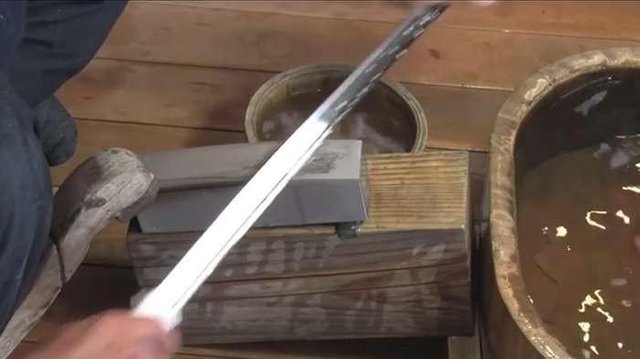Difficult to Make Swords The Japanese Samurai, Can 3 Months Even Half Year

It is not easy to make swords for samurai (Japanese knights). Can spend at least 3 months or even half a year for one sword.
Not long ago Tribunnews.com visited the swordmakers in Setouchi Wakayama.
It turns out that the process takes a natural time and a lot of swordsmen with their expertise are involved in a process of sword making.
The first process by selecting the best type of material is the Tamahagane (steel gem) type selected from the iron ore with a very thorough process.
This best steel material is forged together. Generally difficult to do alone, and usually done three in the hot stove can be 1300 degrees Celsius.
The best iron forging process is called Katanakaji which is continuously forged (hammered) with a weighted hammer of about 8 kilograms repeatedly and alternately, in order to become a long iron katana (sword) is nice and flat (slightly curved).
Making a long katana that was not just to form a long iron sword alone, it turns out by laminated best quality steel iron, and then forged again to be katana with the best shape.
The swords that are finished forged form a good sword, marked with clay and coal and polish powder so that later can shine.
This coating work is included in the thin sword blades.
While in the body of the coating sword is also by marking the sword of a wavy design called Hamon, which will appear more clearly during the process of rubbing. Then burned a little more, cooled.
After that the second process called Togishi is sharpen the sword and polish polish to shine.
This effort according to Shinichi Fukutake, Japanese togishi experts, performed many times by using seven different and different sharpening stones.
This grinding process is up to 12 steps including hazuya, jizuya, nugui and so on.
For a sword of 70 cm long requires about 80-100 hours of grinding or polishing so that the sword becomes shiny and sharp.
So sharp that even a very thin silk is easily split just by the samurai's sword.
The third process of Shiroganeshi is to protect the sword so as not to rust undamaged, by coating the metal on the bridge between the body of the sword and the location of the hand to hold the sword.
I Kishino reveals using about 20 tools to make that sword shield and the process of making it for 12 hours.
Then enter the fourth process of Sayashi or making a wooden sword sheath. The length of manufacture can be between 4 to 5 days according to Saburo Ishizaki, the expert of wooden scabbard gloves.
"Then the Nurishi process is coating the sword sheath with polish paint and can last about 2-3 months," said Teruhito Kishino, expert coat of sword sheath with special paint.
Painting of sword sheath is done about 10 times until the sword sheath looks shiny.
The 6th process is Chokinshi or carve the body part of the sword by an expert named Shigetsune Katayama.
"Usually using images or natural designs, including the Phoenix bird, but if the image of people is no longer there," he explained.
To carve the body of the sword Katayama uses 200 carvers. But usually senior experts use 2,000 tools or 10 times more to very fine carvings.
The last 7th process is called Tsukamakishi, which is a decoration on the handle of the sword.
"The ornate parts of the hand or the handle of the sword are not just ornamentation, but the knitting is special and the hardest to do is a diamond knitting model called Jabaramaki so the sword looks very beautiful," said Shuji Mitani, an expert on Tsukamakishi.
The handle of the sword shall be one spirit shall one soul shall be one body with the one who holds it.
Therefore, the handle of the sword is very important to feel united with the sword maker.
Holded not only tightly but also firmly held and seemed to be a single thought with the man who holds and controls it.
That is the seven process of making the Japanese Samurai sword (katana) which is very difficult but it has one special art and has deep philosophical meaning which is done by one team, can not by one person only.
And each part has its own expertise as well, so it becomes as if a living, callous-minded object as a human being holds it.
That's the sword of the Japanese samurai.
One place for the swordmaking museum that was recommended was the Bizen Osafune Sword Museum in Osafune City, Okayama Prefecture Setouchi.
This musem is just 7 minutes by taxi from JR Osafune railway station.
Closed Mondays. Entrance fee is only 500 yen per person.